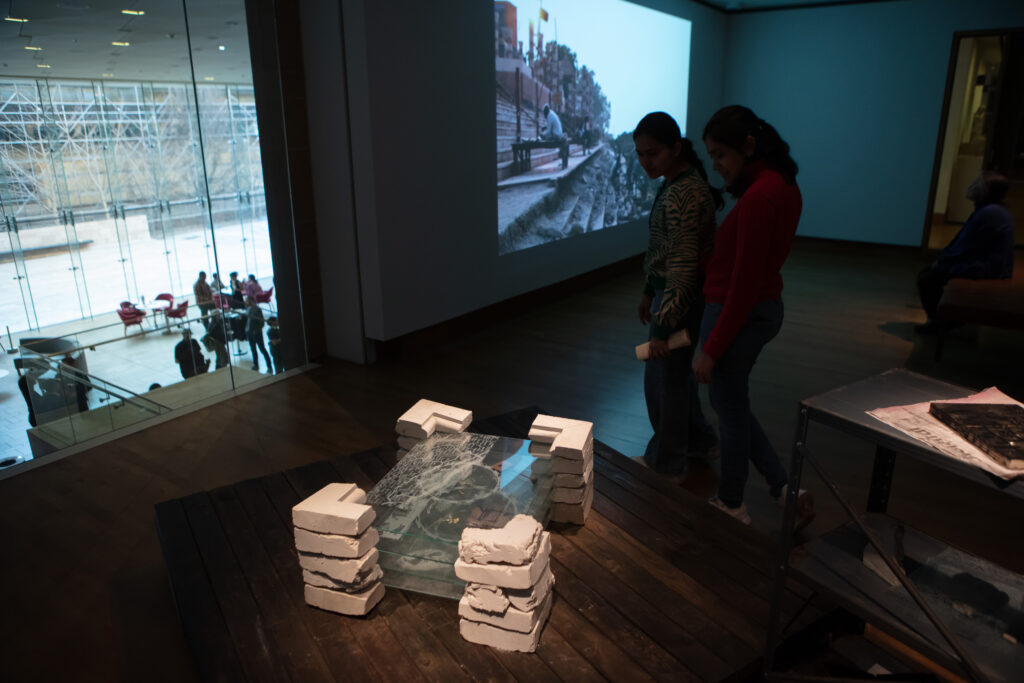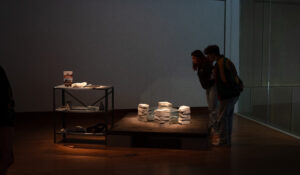UW–Madison MFA candidate Anamika Singh has been awarded this year’s Russell and Paula Panczenko MFA Prize, an honor that includes a solo exhibition at the Chazen Museum of Art.
Corpus: An Exhibition by Anamika Singh is on view in the Chazen’s Garfield Galleries through July 13.
In this interview, Singh shares the inspiration behind her exhibition, reflects on the experience of seeing it come to life, and discusses what she hopes audiences will take away. Portions of this article are drawn from a conversation with Blue Water Communications.

Tell us about the overall theme of Corpus.
While this work begins with familial histories, it really quickly unravels into looking at much vaster histories of the Indian subcontinent, specifically of North India, where I’m from, through the monumental life of my granduncle, who was Sheetla Singh, a prominent editor, journalist, and union leader in North India. I’ve really been able to explore the transformation of the region and the nation itself. But in short, the work really reckons with this continuity of violence that’s unfolding in many, many different forms.
This work centers on the 1992 destruction of the Babri Mosque in Ayodhya, Faizabad. Can you explain its significance for those who are less familiar with the history of India?
The desecration of the Babri Mosque completely shifted the axis of not just Indian politics, but the greater subcontinent. This moment marked a rapid rise of the Hindu nationalist movement and the violence that unfolded afterward continues to deeply impact political and social relations. Within Uttar Pradesh now, numerous mosques are contested, with calls for archaeological surveys of them. This is a phenomenon that has grown out of the violence of 1992. These have been very tense situations, often resulting in state violence and communal violence, while these surveys are accompanied by the displacement and destruction of marginalized communities. Erasure in such political projects precedes the assertions and claims of a singular dominant history and identity, in this case of a modern Hindu nation-state.
How did you develop this body of work?
Corpus comes from over three years of artistic research, which included site visits and field research in India for several weeks at a time. That would usually involve interviews and visits to different places, and archival research at the newspaper. During this time, I was also filming Sheetla, an experimental film about my granduncle. So, the work has really come together through a lot of different methods, some of which are academic and ethnographic methods, but also at the same time just playing around and experimenting in the studio. It really brings together these two very different ways of making work, while at the same time thinking about the volatility of the material itself.
What will people see when they walk through?
This is an intermedia exhibition, so there’s installation, much of which is using concrete, stainless steel, and a lot of different materials. There’s photography in the show and also quite a bit of moving imagery, both projection and monitors. Visitors can interact with both the moving images from the documentary and from my field research, but also with the sculptures that were synthesized in my studio. One thing I’m really hoping is for visitors to really have a chance to sift through the debris. My work really looks at ideas of construction and destruction, and the tension between them.
What do you hope audiences will take away from the exhibition?
I would want for visitors to think critically about things like how value is assigned, be it to a body of knowledge or to an object, and to think about these hierarchies and things that cross geopolitical boundaries. I would also want them to question ideas of development and construction that are driving our current world, this rapid transformation and change of the landscape.
I think art has the power to generate both new language, to address our experiences of the world, and address really uneasy things, like legacies of violence. But I think it also has the power to really challenge dominating systems of knowledge. Especially in this context, I think about colonial violence. I think about nationalist violence. Art has the freedom of material form and process that other disciplines are constrained by, which really gives artists the tools to move beyond totalizing narratives.
 What were some of the curatorial decisions made as Corpus was coming together in the galleries?
What were some of the curatorial decisions made as Corpus was coming together in the galleries?
I wanted to take the audience through a journey I had taken myself as I returned to the Awadh and experienced it amongst massive transformation and increasing communal strife and tensions. So, the first gallery space which houses the large-scale installation, resurrected corpus; in the aftermaths of empire, is an ode to that. There are also several thresholds you cross in the space, such as The Gates, that invite you into the space but also the audio, designed by X Medianoche, which sits between the two galleries, permeating both. As visitors move from the first gallery into the second, I wanted to bring them into the space of offices and archives. In a way, I wanted them to experience the many modes in which power and subjugation manifests itself, to draw the parallels between physical erasure and the erasure of memory and knowledge.
How did it feel to walk through the exhibition for the first time?
It’s hard to describe. It’s incredibly moving. There is both a sense of relief in bringing the work to fruition, but in some sense a sadness as you depart with the work. Much of this work has lived in my studio and in some ways, I lived with them. So, your relationship with the work changes as you step back and experience it as the audience might. The conversation unfolding between the different media and materials in the space has been very generative for me. It affirms my affinity to keep working in this way.
The Panczenko Prize is offered by the Chazen and the UW–Madison Art Department with support from the Russell and Paula Panczenko Fund for Excellence in the Visual Arts.